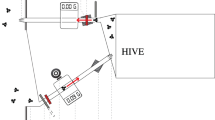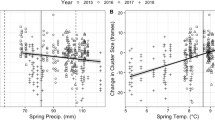Abstract
To investigate the distances at which honey bee foragers collect nectar and pollen, we analysed 5,484 decoded waggle dances made to natural forage sites to determine monthly foraging distance for each forage type. Firstly, we found significantly fewer overall dances made for pollen (16.8 %) than for non-pollen, presumably nectar (83.2 %; P < 2.2 × 10−23). When we analysed distance against month and forage type, there was a significant interaction between the two factors, which demonstrates that in some months, one forage type is collected at farther distances, but this would reverse in other months. Overall, these data suggest that distance, as a proxy for forage availability, is not significantly and consistently driven by need for one type of forage over the other.



Similar content being viewed by others
References
Barron, A.B., Maleszka, R., Vander Meer, R.K., Robinson, G.E. (2007) Octopamine modulates honey bee dance behavior. Proc. Natl. Acad. Sci. U. S. A. 104(5), 1703–1707
Beekman, M., Ratnieks, F.L.W. (2000) Long-range foraging by the honey-bee, Apis mellifera L. Funct. Ecol. 14(4), 490–496
Boch, R. (1957) Rassenmässige Unterschiede bei den Tänzen der Honigbiene (Apis mellifica L.). Z. Vgl. Physiol 40(3), 289–320
Brown, J.S., Kotler, B.P. (2004) Hazardous duty pay and the foraging cost of predation. Ecol. Lett. 7(10), 999–1014
Cagnacci, F., Boitani, L., Powell, R.A., Boyce, M.S. (2010) Animal ecology meets GPS-based radiotelemetry: a perfect storm of opportunities and challenges. Philos. Trans. R. Soc. Lond. B Biol. Sci. 365(1550), 2157–2162
Couvillon, M.J. (2012) The dance legacy of Karl von Frisch. Insect. Soc. 59(3), 297–306
Couvillon, M.J., Riddell Pearce, F.C., Harris-Jones, E.L., Kuepfer, A.M., Mackenzie-Smith, S.J., et al. (2012) Intra-dance variation among waggle runs and the design of efficient protocols for honey bee dance decoding. Biol. Open 1(5), 467–472
Couvillon, M.J., Fensome, K.A., Quah, S.K.L., Schürch, R. (2014a) Summertime blues: August foraging leaves honey bees empty-handed. Comm. Integr. Biol. 7(1), e28821
Couvillon, M.J., Schürch, R., Ratnieks, F.L.W. (2014b) Waggle dance distances as integrative indicators of seasonal foraging challenges. PLoS ONE 9(4), e93495
Crailsheim, K. (1992) The flow of jelly within a honeybee colony. J. Comp. Physiol. B. 162(8), 681–689
Danka, R.G., Hellmich II, R.L., Rinderer, T.E., Collins, A.M. (1987) Diet-selection ecology of tropically and temperately adapted honey bees. Anim. Behav. 35(6), 1858–1863
Esch, H.E., Zhang, S., Srinivasan, M.V., Tautz, J. (2001) Honeybee dances communicate distances measured by optic flow. Nature 411(6837), 581–583
García, L.V. (2004) Escaping the Bonferroni iron claw in ecological studies. Oikos 105(3), 657–663
Gardner, K.E., Seeley, T.D., Calderone, N.W. (2008) Do honeybees have two discrete dances to advertise food sources? Anim. Behav. 75(4), 1291–1300
Grubb Jr., T.C., Greenwald, L. (1982) Sparrows and a brushpile: foraging responses to different combinations of predation risk and energy cost. Anim. Behav. 30(3), 637–640
Grüter, C., Leadbeater, E., Ratnieks, F.L.W. (2010) Social learning: the importance of copying others. Curr. Biol. 20(16), R683–R685
Grüter, C., Moore, H., Firmin, N., Helanterä, H., Ratnieks, F.L.W. (2011) Flower constancy in honey bee workers (Apis mellifera) depends on ecologically realistic rewards. J. Exp. Biol. 214(8), 1397–1402
Hughes, J.J., Ward, D. (1993) Predation risk and distance to cover affect foraging behaviour in Namib Desert gerbils. Anim. Behav. 46(6), 1243–1245
Jeanne, R.L. (1986) The organization of work in Polybia occidentalis: costs and benefits of specialization in a social wasp. Behav. Ecol. Sociobiol. 19(5), 333–341
Kacelnik, A., Houston, A.I., Schmid-Hempel, P. (1986) Central-place foraging in honey bees: the effect of travel time and nectar flow on crop filling. Behav. Ecol. Sociobiol. 19(1), 19–24
Krebs J.R., N.B. Davies. (2009) Behavioural ecology: an evolutionary approach. Wiley-Blackwell.
Lindauer, M. (1955) Schwarmbienen auf wohnungssuche. Z. Vgl. Physiol 37(4), 263–324
Michelsen, A., Andersen, B.B., Storm, J., Kirchner, W.H., Lindauer, M. (1992) How honeybees perceive communication dances, studied by means of a mechanical model. Behav. Ecol. Sociobiol. 30(3/4), 143–150
Pankiw, T., Page Jr., R.E. (2000) Response thresholds to sucrose predict foraging division of labor in honeybees. Behav. Ecol. Sociobiol. 47(4), 265–267
Pesante, D., Rinderer, T.E., Collins, A.M. (1987) Differential pollen collection by Africanized and European honeybees in Venezuela. J. Apic. Res. 26, 24–29
Porter, S.D., Jorgensen, C.D. (1981) Foragers of the harvester ant, Pogonomyrmex owyheei: a disposable caste. Behav. Ecol. Sociobiol. 9(4), 247–256
Rinderer, T.E. (1988) Evolutionary aspects of the Africanization of honey-bee populations in the Americas. In: Needham, G.R., Page, R.E., Definado-Baker, M., Bowman, C. (eds.) Africanized honey bees and bee mites, pp. 13–28. Westview Press, Boulder
Robinson, G., Page Jr., R. (1989) Genetic determination of nectar foraging, pollen foraging, and nest-site scouting in honey bee colonies. Behav. Ecol. Sociobiol. 24(5), 317–323
Schmid-Hempel, P. (1987) Efficient nectar-collecting by honeybees I. Economic models. J. Anim. Ecol. 56(1), 209–218
Schmid-Hempel, P., Schmid-Hempel, R. (1987) Efficient nectar-collecting by honeybees II. Response to factors determining nectar availability. J. Anim. Ecol. 56(1), 219–227
Schneider, S.S. (1989) Spatial foraging patterns of the African honey bee, Apis mellifera scutellata. J. Insect Behav. 2(4), 505–521
Schneider, S.S., Blyther, R. (1988) The habitat and nesting biology of the African honey bee Apis mellifera scutellata in the Okavango River Delta, Botswana, Africa. Insect. Soc. 35(2), 167–181
Schneider, S.S., McNally, L.C. (1992) Seasonal patterns of foraging activity in colonies of the African honey bee, Apis mellifera scutellata, in Africa. Insect. Soc. 39(2), 181–193
Schürch, R., Couvillon, M.J., Burns, D.D.R., Tasman, K., Waxman, D., et al. (2013) Incorporating variability in honey bee waggle dance decoding improves the mapping of communicated resource locations. J. Comp. Physiol. A. Neuroethol. Sens. Neural. Behav. Physiol. 199(12), 1143–1152
Seeley, T.D. (1985) Honeybee ecology. Princeton University Press, Princeton
Seeley, T. (1989) Social foraging in honey bees: how nectar foragers assess their colony's nutritional status. Behav. Ecol. Sociobiol. 24(3), 181–199
Seeley, T.D. (1994) Honey bee foragers as sensory units of their colonies. Behav. Ecol. Sociobiol. 34(1), 51–62
Seeley, T.D. (1995) The wisdom of the hive. Harvard University Press, Cambridge
Seeley, T.D., Buhrman, S.C. (1999) Group decision making in swarms of honey bees. Behav. Ecol. Sociobiol. 45(1), 19–31
Seeley, T., Camazine, S., Sneyd, J. (1991) Collective decision-making in honey bees: how colonies choose among nectar sources. Behav. Ecol. Sociobiol. 28(4), 277–290
Seeley, T.D., Mikheyev, A.S., Pagano, G.J. (2000) Dancing bees tune both duration and rate of waggle-run production in relation to nectar-source profitability. J. Comp. Physiol. A. 186(9), 813–819
Srinivasan, M.V., Zhang, S., Altwein, M., Tautz, J. (2000) Honeybee navigation: nature and calibration of the "odometer". Science 287(5454), 851–853
Steffan-Dewenter, I., Kuhn, A. (2003) Honeybee foraging in differentially structured landscapes. Proc. R. Soc. B Biol. Sci. 270(1515), 569–575
Visscher, P., Dukas, R. (1997) Survivorship of foraging honey bees. Insect. Soc. 44(1), 1–5
Visscher, P.K., Seeley, T.D. (1982) Foraging strategy of honeybee colonies in a temperate deciduous forest. Ecology 63(6), 1790–1801
von Frisch, K. (1946) Die Tänze der Bienen. Österr. Zool. Z. 1, 1–148
von Frisch, K. (1967) The dance language and orientation of bees. Harvard University Press, Cambridge
Waddington, K.D., Herbert, T.J., Visscher, P.K., Richter, M.R. (1994) Comparisons of forager distributions from matched honey bee colonies in suburban environments. Behav. Ecol. Sociobiol. 35(6), 423–429
Weimerskirch, H., Bonadonna, F., Bailleul, F., Mabille, G., Dell'Omo, G., et al. (2002) GPS tracking of foraging albatrosses. Science 295(5558), 1259
Winston, M.L. (1987) The biology of the honey bee. Harvard University Press, Cambridge
Acknowledgments
We would like to thank Ellie Blows and Sarah Hudson for being volunteer dance decoders. MJC is funded by a donation from The Nineveh Charitable Trust, UK. Waitrose Ltd. provided funds for a research MSc (to FCRP) and summer undergraduate research bursaries (to CA, KAF, SKLQ, and ET). Additional research funding was provided by Burt’s Bees, The Body Shop Foundation, and Rowse Honey Ltd.
Author information
Authors and Affiliations
Corresponding author
Additional information
Manuscript editor: David Tarpy
La distance de butinage de l’abeille varie en fonction du mois et du type de substance récoltée
Disponibilité de l’approvisionnement / danse de recrutement / Apis mellifera / nectar / pollen
Die Sammeldistanz bei Honigbienen hängt vom Monat und Art des Sammelns ab
Trachtvorkommen / Schwänzeltanz / Apis mellifera / nektar / pollen
Rights and permissions
About this article
Cite this article
Couvillon, M.J., Riddell Pearce, F.C., Accleton, C. et al. Honey bee foraging distance depends on month and forage type. Apidologie 46, 61–70 (2015). https://doi.org/10.1007/s13592-014-0302-5
Received:
Revised:
Accepted:
Published:
Issue Date:
DOI: https://doi.org/10.1007/s13592-014-0302-5




